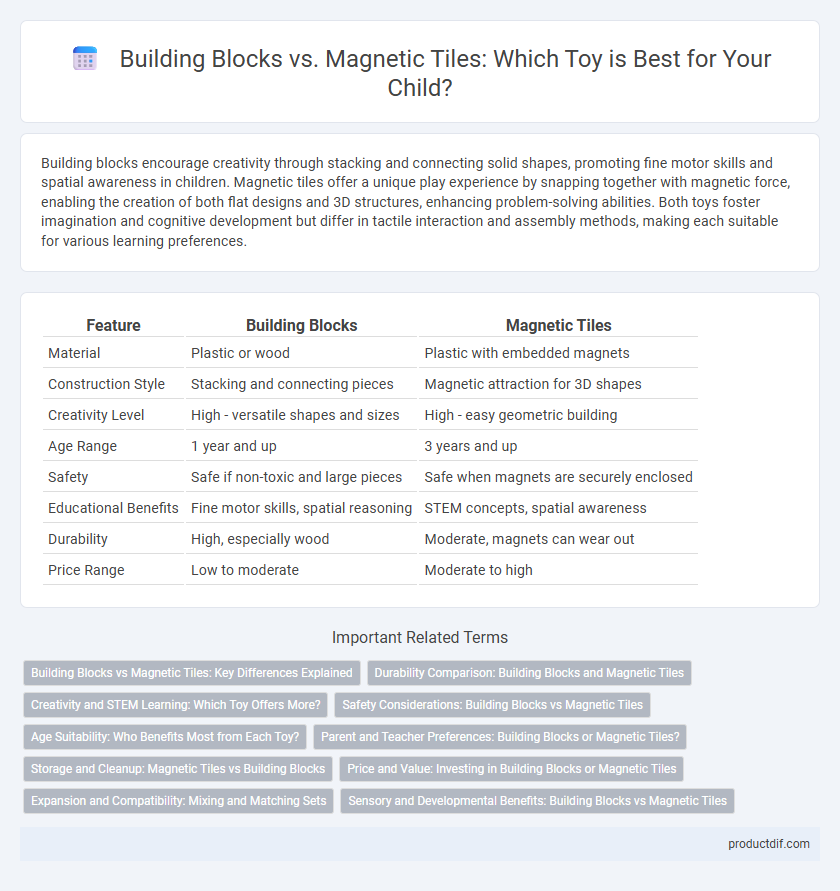Building blocks encourage creativity through stacking and connecting solid shapes, promoting fine motor skills and spatial awareness in children. Magnetic tiles offer a unique play experience by snapping together with magnetic force, enabling the creation of both flat designs and 3D structures, enhancing problem-solving abilities. Both toys foster imagination and cognitive development but differ in tactile interaction and assembly methods, making each suitable for various learning preferences.
Table of Comparison
| Feature | Building Blocks | Magnetic Tiles |
|---|---|---|
| Material | Plastic or wood | Plastic with embedded magnets |
| Construction Style | Stacking and connecting pieces | Magnetic attraction for 3D shapes |
| Creativity Level | High - versatile shapes and sizes | High - easy geometric building |
| Age Range | 1 year and up | 3 years and up |
| Safety | Safe if non-toxic and large pieces | Safe when magnets are securely enclosed |
| Educational Benefits | Fine motor skills, spatial reasoning | STEM concepts, spatial awareness |
| Durability | High, especially wood | Moderate, magnets can wear out |
| Price Range | Low to moderate | Moderate to high |
Building Blocks vs Magnetic Tiles: Key Differences Explained
Building blocks are solid pieces made from plastic, wood, or foam that stack and interlock through friction, fostering fine motor skills and spatial reasoning. Magnetic tiles consist of flat, translucent panels with embedded magnets, allowing children to snap pieces together to form 3D structures easily and explore magnetic properties. Unlike building blocks, magnetic tiles offer the added benefit of hands-on STEM learning through magnetism, enhancing creativity and science comprehension.
Durability Comparison: Building Blocks and Magnetic Tiles
Building blocks, often made from high-quality plastic or wood, tend to offer greater durability and resistance to impact compared to magnetic tiles, which feature plastic frames with embedded magnets that can wear out or break under frequent use. Magnetic tiles provide unique creative possibilities through their magnetic connections but may require careful handling to avoid damage to the magnets or tiles themselves. In terms of long-term durability, traditional building blocks generally withstand rough play and repeated assembly better than magnetic tiles.
Creativity and STEM Learning: Which Toy Offers More?
Building blocks promote creativity by allowing limitless configurations and hands-on construction, fostering fine motor skills and spatial awareness in STEM learning. Magnetic tiles introduce magnetic properties that enable complex geometric structures and teach fundamental concepts of magnetism, engineering, and physics. Both toys enhance STEM skills, but magnetic tiles provide a unique advantage through interactive science-based exploration alongside imaginative play.
Safety Considerations: Building Blocks vs Magnetic Tiles
Building blocks made from non-toxic, BPA-free plastic or wood are generally safer for young children, as they lack small parts that could pose choking hazards. Magnetic tiles contain strong magnets that, if swallowed, can cause serious internal injuries, making them less suitable for toddlers and requiring close adult supervision. Both toys should meet ASTM F963 safety standards to ensure durability and non-toxicity.
Age Suitability: Who Benefits Most from Each Toy?
Building blocks are ideal for children aged 3 to 8, supporting fine motor skills, spatial awareness, and creativity through hands-on construction. Magnetic tiles suit slightly older kids, around 5 to 12 years, encouraging more advanced STEM learning, problem-solving, and magnetic experimentation. Both toys enhance cognitive development but cater to different age-related motor and cognitive abilities.
Parent and Teacher Preferences: Building Blocks or Magnetic Tiles?
Parents and teachers often prefer building blocks for their tactile engagement and developmental benefits in fine motor skills and spatial reasoning. Magnetic tiles are favored for encouraging creativity and STEM learning through easy-to-connect pieces that foster imagination and problem-solving. Both toys support cognitive growth, but preferences typically hinge on the balance between hands-on manipulation and open-ended construction.
Storage and Cleanup: Magnetic Tiles vs Building Blocks
Magnetic tiles offer a compact storage solution as their flat, interlocking design allows them to stack neatly, reducing clutter and simplifying cleanup. Building blocks, with varied shapes and sizes, often require divided containers or multiple bins for organized storage, which can lead to scattered pieces and longer cleanup times. Efficient storage of magnetic tiles supports quicker play session transitions, while building blocks may demand more effort to maintain an orderly play area.
Price and Value: Investing in Building Blocks or Magnetic Tiles
Building blocks typically offer a more affordable price point compared to magnetic tiles, making them a budget-friendly option for extended play. Magnetic tiles, while pricier, provide enhanced value through their unique magnetic connections that encourage creativity and STEM learning. Investing in magnetic tiles can yield long-term educational benefits, whereas building blocks appeal to those seeking versatile and cost-effective toy solutions.
Expansion and Compatibility: Mixing and Matching Sets
Building blocks offer extensive expansion opportunities due to their standardized shapes and sizes, allowing seamless integration with numerous brands and sets. Magnetic tiles provide unique compatibility by enabling pieces to connect at various angles, encouraging creative architectural designs while remaining compatible within the same brand's range. Both toys support mix-and-match play, but building blocks excel in universal expansion, whereas magnetic tiles emphasize versatile connections and innovative construction.
Sensory and Developmental Benefits: Building Blocks vs Magnetic Tiles
Building blocks enhance fine motor skills, hand-eye coordination, and spatial reasoning through tactile manipulation and stacking activities. Magnetic tiles stimulate creativity and problem-solving by encouraging children to explore magnetic forces and geometric construction, promoting cognitive development and sensory exploration. Both toys support sensory integration but differ in their engagement with physical dexterity versus magnetic and visual feedback.
Building block vs Magnetic tile Infographic

 productdif.com
productdif.com